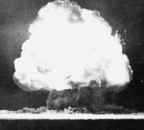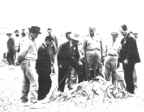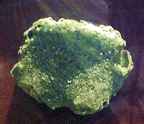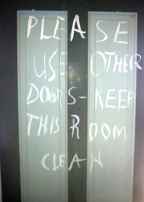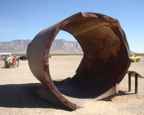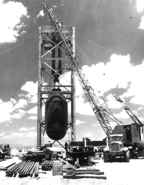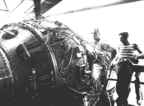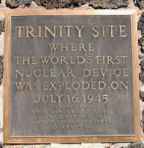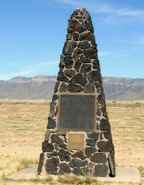A-BOMB - THE DESTROYER OF WORLDS
At 5:29:45 AM on July 16, 1945 a 19-kiloton plutonium bomb, the first in history, was exploded at Trinity. Here's what Trinity looks like today, what it looked like in 1945 during WWII, the history of the Manhattan Project and the theory and reasons behind the bomb. "Now I am become death, the destroyer of worlds" (a line from Hindu scripture quoted by Robert Oppenheimer when he observed the test.)
|
"The effects could well be called unprecedented, magnificent, beautiful, stupendous, and terrifying. No man-made phenomenon of such tremendous power had ever occurred before. The lighting effects beggared description. The whole country was lighted by a searing light with the intensity many times that of the midday sun." <5> Brig. Gen. Thomas Farrell |
|
At 5:29:45 AM on July 16, 1945, a 19-kiloton plutonium bomb, the first in history, was exploded at Trinity. Both the test and the site were named by Robert Oppenheimer. Life changed for everyone on earth. The site, 51,500 acres, was declared a national historic landmark in 1975. The landmark includes ground zero as well as the base site and the McDonald ranch (where the core was assembled.) In each of the three atomic bombs, the core of fissionable material was about the size of a grapefruit. <6> Trinity-October
2002 |
|
The site
of the world's first atomic bomb explosion is only open to the public
two days per year, the first Saturday; in April and October. This
year we made it in October. We stayed at a small RV park in San
Antonio, NM just off I-25 at US 380. The entrance to Trinity is
about 12 miles east on US380, then about 5 miles south to the gate.
We reached the north entrance where a line of cars waited. At 8:00
A.M., after checking our IDs and
presenting us with a pamphlet, they let us in
|
| for the 17-mile trip into the range. Until
about 11:00 A.M., there were just about 50-100 people there. Shortly
thereafter, a caravan of 117 plus cars and several tour busses arrived
from Los Alamos. There are usually fifteen hundred to three thousand
people at each visit. There were about two thousand today. Usually
the October opening has fewer visitors than the one in April.
What about all that scary talk about radiation? The radiation at the site of the worlds first plutonium bomb, 62 years later is low; only 10 times that of the surrounding background levels. To put this in perspective, here are some comparisons: in one hour at ground zero, we received ½ mrem of radiation. If we smoked a pack of cigarettes a day for one year, we would receive 40 mrem. Chest X-rays? = 22 mrem. A whole mouth dental x-rays, 900 mrem. <5> |
|
The crater is relatively small – only about 6' deep. The explosion was 100' up in a tower and was directed upward. The explosion vaporized the tower. Only one concrete footing and pieces of the steel legs remain. The heat melted the desert sand turning it into a green glassy substance named Trinitite. Small amounts are left and are on display both at the entrance and in a low structure that protects a portion of the original crater. The McDonald house, where |
|
Gunnery range. It was abandoned until early 1945 when it was put back in use by the Manhattan project personnel. The northeast room was used as the assembly room and was sealed with tape and plastic. The crude sign scrawled on the door to that room was also preserved, "Wipe feet to keep out dust." I can't imagine it worked. There must still be dust from New Mexico in Hiroshima and Nagasaki. The building was hardly damaged by the explosion two miles away but the barn roof was collapsed in places. It remains as ruins of the walls today.
|
|
|
For more information
about visiting the site, contact:
Public Affairs Office
Bldg. 122
Whit Sands Missile Range, NM 88002
(505)678-1134
Time Line
1890s A series of
accomplishments by European and British scientists
1932 James Chadwick, an Englishman, discovered a new subatomic particle,
the neutron.
1938 Otto Hahn and Fritz Strassmann, German scientists, split the uranium
atom. This splitting was later referred to as fission.
1938 Lise Meitner and Otto R Frisch were able to explain the process of
fission.
1939 Einstein's famous letter
to President Roosevelt suggesting the feasability of building an atomic
bomb and the possibility that the Germans were well on their way to building
one. Actually, not true, the Germans abandoned their efforts in the fall
of 1942<6>
1940 Otto Frisch and Rudolf E. Peierls, in England, described the concept
that a specific amount of fissionable material had to come together to
achieve an explosion. This was called "critical mass."
2/1942 Glen T. Seaborg created the first plutonium. It, like Uranium,
is highly fissionable.
9/1942 Leslie R. Groves was placed in charge of MED (the Manhattan Project
– see History below) and promoted to Brigadier general.
12/2/1942 The first self sustaining chain reaction accomplished by a team
of scientists led by Enrico Fermi at the University of Chicago.
3/15/1943 Robert Oppenheimer arrived as director of the weapons laboratory
at Los Alamos (yet to be built.) He named the test and the test site "Trinity."
7/16/1945 The first atomic bomb tested at Trinity
|
In a letter dated August 2nd 1939, Albert Einstein, pushed by Leo Szilard, a Hungarian scientist living in the US, wrote to President Roosevelt suggesting that it was possible to build a bomb that, if delivered by ship ". . . might very well destroy the whole port . . ." Two years later on October 9th 1941, Roosevelt, influenced also by the British "MAUD" report, made the decision to build the bomb. Soon a special section of the Army named Manhattan Engineer Division (MED) was established to undertake the job. It was later commonly referred to as the Manhattan Project. The Manhattan Project was three large facilities. Since uranium and |
Oak Ridge TN where huge gas diffusion and electromagnet process plants were built to separate U235 from it's more common U238. This is known as "enrichment" or enriched uranium.
Hanford Washington Nuclear reactors that produced plutonium. Plutonium is, for all practical purposes, man made. It is not then one of the 92 elements existing in nature (except as traces) and is a by-product of a chain reaction pile.
Los Alamos was to
design and build the bombs. It started as a private residential boys'
school called the Los Alamos Ranch School. It was located on a remote
mesa 35 miles NW of Santa Fe. It was converted to an Army base and sealed
off from the rest of the world. Its population is estimated at about five
thousand in 1945.
|
When they decided that the plutonium bomb needed testing (see "The Theory" below) they searched for a place to explode it. The Alamogordo Bombing Range was established in land already controlled by the government in 1942. The area known as Jornada del Muerto (journey of the dead) was chosen for its isolation. They were so concerned that the plutonium |
|
exploded but the plutonium did not. Later, they decided not to use Jumbo because they became more confident that the device would work. During the explosion, Jumbo was under a steel tower about 800 yards from ground zero. The blast destroyed the steel tower but left Jumbo undamaged. In 1946, they set off eight 500# bombs inside Jumbo. The ends were blown out. The main part of Jumbo stands today at the entrance to ground zero. Three observation points were built around ground zero – none are left. At ground zero a 100 foot steel tower was built. The complicated device, now nicknamed the "gadget" was lifted to a small shack on top. At 5:29:45 the plutonium bomb exploded successfully.
|
The Theory
To build a bomb, they had to devise a way to transport and handle the fissionable material but be able to create a critical mass instantly from the two or more non-critical masses. They had the two elements that were fissionable and would support a chain reaction (in theory) so they came up with two methods of combining the sub-critical masses into critical mass for the bombs.
A uranium bomb's method of combining the masses using the "gun" method was relatively simple so they decided to use it without testing. The plutonium bomb, using the implosion method was much more complicated so they felt it needed testing.
The two methods of compressing the fissionable core into a critical mass were: the gun method where the core was built in two sub critical pieces. One was then fired against the other in a tube receiver, creating a critical mass – the uranium bomb (Hiroshima, called Little Boy estimated 12,500 tons of TNT) used this method. The other method was to build the core into a sub critical sphere of plutonium (Nagasaki, called Fat Man estimated 20,000 tons of TNT) and surround it with lens shaped conventional explosives. The force was directed inwards crushing the plutonium uniformly into a critical mass. In each case, the explosion of the now critical mass was instantaneous.
When a chain reaction
starts, reaction increases speed as atoms split. This releases a great
amount of energy as well as free neutrons. They, in turn, strike more
atoms releasing more energy and neutrons until the fissionable material
is used up. This all occurs in a millionth of a second, even though billions
of atoms are split.
|
The Reason It is impossible for someone in this relatively clean, safe world to imagine the savagery and brutality of WWII. This was especially true in the Pacific. "The Japanese soldier turned all Western logic on its head. If surrounded, a German would surrender; a Japanese would fight on. If wounded and disabled, an Englishman would allow himself to surrender; a Japanese would wait and blow himself and his captor up." <1> In the West, there had been |
The last great banzai charge (that had served the Japanese so well in the Russian war and in China) was on Saipan. (See Rainbow over Hell) There they realized that the firepower brought to bear by the Americans threw the obsolete banzai charge on the dust heaps of history. There were several small or individual ones that continued, when all was lost, as a last effort to take an American to death with them but no more mass, organized charges. On Iwo Jima and Okinawa, the tactics changed. The commander at Iwo Jima, Tadamichi Kuribayashi, Hirohito's "most redoubtable" commander (See The Emperor's Reluctant Warrior,) decided that there would be no banzai charges. He knew he had to do what he could with no help from Tokyo so he built thirteen thousand yards of tunnels and five thousand cave entrances or pillbox gun emplacements – on eight square miles of island! "They meant to make the conquest of Iwo Jima so costly that the Americans would recoil from the thought of invading their homeland."<2> They did! 25, 850 young Marine casualties. See "An Invasion Not Found in the History Books" The Marines fought in World War II for forty-three months. Yet in one month on Iwo Jima , one third of their total deaths occurred." <1> 25,850 Marines on one stinking (literally – it's name in Japanese means Sulfur Island) eight square mile island. It is hard to grasp that figure. Three thousand were lost in the World Trade center. 2403 were lost at Pearl Harbor, <4> nearly two hundred at the Alamo, Almost 26,000 casualties on Iwo Jima. If these casualties were laid end to end, they would reach from Dallas to fort Worth, from Manhattan to New Brunswick or from Beverly Hills to the Queen Mary.
On the much larger Okinawa, 207, 283 <2> combatants and civilians died (more than 50,000 American.) <3> This is more than died from either atom bomb. As the carnage to discourage the invasion of Japan continued under General Mitsura Ushijima, waves of kamikazes called "kikusui" (floating chrysanthemums) desperately and effectively added to the mounting losses that included the Allied Commander, General Buckner; the Japanese commander, General Mitsura; and Ernie Pile. The total cost in casualties of taking the two islands, Iwo Jima and Okinawa, exceeded those of the previous three years of war in the Pacific.
William Manchester
in Goodbye Darkness wrote "Rooting them out became a bloody
business which reached its ultimate horrors in the last months of the
war.. You think of the lives that would have been lost in an invasion
of Japan's home islands – a staggering number of American lives but
millions more of Japanese – and you thank God for the atomic bomb."<2>
Speaking on the History Channel about
the two atomic bombs dropped on Japan, Colonel Walter Boyne, USAF retired
said: "As horrible as it is to say, it was a blessing because the
Japanese people were able to surrender then. Their military did not permit
them to surrender – wouldn't countenance it until finally, after
the second bomb was dropped, the Emperor insisted on it. Had they continued
fighting, there would have been all the casualties on the American side.
There would have been all Japanese casualties during the invasion and
there would have been five or six million Japanese deaths to starvation
because they were completely isolated from their food supplies."
It has to be recognized that, in one way, the Japanese tactics worked. Did they win the battles of Iwo Jima and Okinawa because of this? The Allies certainly did recoil at the thought of invading the Japanese islands. MacArthur predicted more than one million American dead and untold millions of Japanese civilians would die. Old men, women, and children were already being taught to fight to the death with anything available – but take at least one American with them. Americans invading Japan would now have to fear approaching Japanese children instead of giving them chocolate as in Europe or shoot beautiful petite Japanese women instead of admiring them. Was it one result of the new tactics that the "unconditional surrender" of Japan had many conditions, not the least of which was the preservation of the Emperor and much milder prosecution of war crimes than in Europe (177 German war criminals tried while only 28 Japanese)?<3>
| So, in 1945, as their tactics seemed to be working, that Japanese tenacity forced upon the Allies a horrible dilemma: invade at unbelievable loss of life or blockade Japan and wait for it to wither the vine. Japan, like England, is an island and must import much of its food. Could the Allies wait for more a year (as Generals Marshall and MacArthur predicted) for the Japanese to starve while they sought to develop their own a bomb and the Soviets moved into more Japanese |
Humanitarian Considerations
Some today question the decision to drop the bomb. There is little of that feeling on the part of those who were living then. Almost without exception, the people living then, whose lives were at stake, had none of these regrets. They, who were closest, say "thank God for the atomic bomb."
The Decision:
Not only was Truman torn making the decision to use the atomic bomb but
according to his papers, was actually considering the other options when
Secretary Byrnes suggested that he also consider what he would say during
his impeachment for letting millions die when he could have stopped the
war. What would he say to the mothers of young men who died when he could
have prevented it?
Warning:
Actually, both cities were flooded with leaflets warning civilians to
leave the city. The Potsdam declaration warned of "complete destruction"
if Japan did not surrender. Both were ignored.
|
UPDATE! Ken Burns, who for over 25 years, has been the best at documentary films, weighs in on the number of bombs after Nagasaki. Among his productions are |
Demonstration Bomb? This was also suggested at the time. Here are a few considerations: The Allies only had three, only two left after the test. Of course they didn't let on, implying they had many more. If a demo had been used, offshore perhaps, and Japan still required two before surrendering, it would have been months before enough plutonium or uranium 235 was prepared for another. There was also the concern that the Soviets would enter the war during the lull. |
UPDATE! There was and maybe still a
forth A-bomb! Ted
Wilkinson, again comes up with exiting new news. Click
the star for details! |
|
The Civil War (1990), Baseball (1994),
Jazz (2001), The War (2007), The National Parks: America's Best
Idea (2009) and Prohibition (2011). The War by Ken Burns! On the book The War, he weighs in on the number of atomic bombs after Nagasaki. In A-Bomb — The Destroyer of Worlds, Kilroy (my nom-de-plume when writing for the site) stated at there were only two left after Trinity (see Demonstration Bomb? above) Since the writing, several people have weighed in, convinced that there was a forth bomb in waiting if Japan did not surrender. In his book, The War. Ken Burns agrees that there was only three and stated it would be weeks before another could have been made ready. |
||
|
The Aftermath The initial result was that WWII, at long last, ended. How much more suffering and loss of life can only be guessed at but ask anyone who was waiting on Saipan, Okinawa, Iwo Jima or Tinian to go to almost certain death in the invasion of the Japanese homeland and he is very clear – "the A-bombs saved my life." I suspect the suffering people of Japan were also quietly relieved when it finally ended, especially when they found that GIs were not monsters and were prepared to be magnanimous in victory. |
In the longer view, wars that were so common throughout history became too terrible to seriously contemplate. The immense power that nuclear combatants could bring to bear forced a more careful decision to start one. Though just as brutal to the participants, hot wars every generation became cold wars and small wars, wars of liberation, and police actions. The cold war lasted half a century without using the full power of any country.
<1>
Flags of our Fathers by James Bradley, Bantom Books,
2000
<2>
Goodbye Darkness by William Manchester, Little, brown and Co., 1979
<3>
War Stories, Ollie North, Fox News Channel
<4>
Infamy by John Toland, Berkley Books, 1983
<5>
U.S. GOVERNMENT PRINTING OFFICE 2000-844-916
<6>
The Manhattan Project: A Secret Wartime Mission edited by Kenneth M. Deitch,
Discovery Enterprises Ltd, 1995
<7>
War at Sea, A Naval History of World War II by Nathan Miller, Scribner,
1995
See Dr. Burl Gilliland's
comments on the decision to use the bomb.
Click
here or see Volume 7, Letters, page 2
See Oscar H. McNew's comments on the decision to use
the bomb
Click
here or see Volume 7, Letters, page 2
